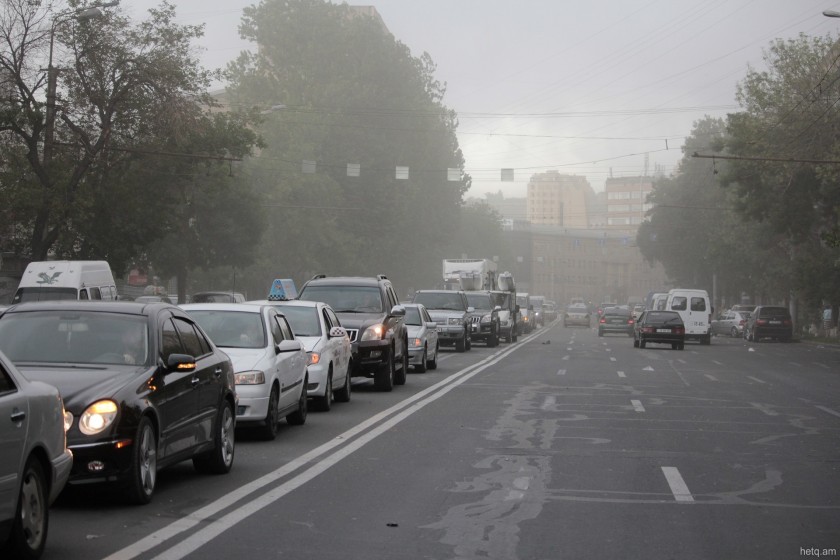
Yerevan’s Worsening Air Quality: Dangerous Levels of Dust, Carbon Monoxide and Sulfur Dioxide Recorded
Gagik Aghbalyan
There are days in Yerevan, the capital of Armenia, when breathing is difficult due to the high levels of various particulates in the air.
The streets are choked with an ever-increasing number of cars and buses. Add to this a decreasing number of green space, and you end up with a toxic mix.
The Environmental Impact Monitoring Center, an arm of the Ministry of Nature Protection, has recently released data showing that higher than acceptable levels of exhaust gases not only plague the center of Yerevan and its southern districts, but also higher elevation residential areas to the north.
The Center has seven monitoring stations in Yerevan that take daily air quality readings. 9,000-10,000 samples are collected yearly.
According to the Center’s findings, 2016 average levels of carbon monoxide, sulfur dioxide, dust and ground-level ozone were within acceptable levels.
But on November 10, at 7:45p.m., carbon monoxide levels hit the roof, reaching 13.13 milligrams per cubic meter – more than 4 times the permissible amount.
One of the hardest hit areas is downtown Yerevan; Khanjian Street in particular. Here, the highest carbon monoxide (CO) readings are registered between 4a.m. and midnight.
I was on February 2, 2016, at 5p.m., that the highest yearly level of sulfur dioxide (SO2) was recorded – 2.93 milligrams per cubic meter – more than 50 times the acceptable norm. This reading was also in downtown Yerevan.
In 2016, 27 higher than acceptable readings of sulfur dioxide were registered in the Kanaker-Zeytoun district of Yerevan (along Azatutyun Avenue); 321 readings of unacceptable nitrogen dioxide (NO2) were recorded in Shengavit; 328 readings of unacceptable dust were recorded in Shengavit (Nzdeh Square); and 1 reading of unacceptable ground-level ozone in Arabkir (Komitas Street).
In the first two months of 2017, 117 readings of unacceptable dust levels were recorded throughout Yerevan.
Prior to 2013, air quality readings were taken at specified hours during the day. Today, readings are taken on a 24-hour basis.
According to figures released by the Ministry of Health, there were 302 registered cases of carbon dioxide poisoning in Armenia in 2016, of which 87 were in Yerevan. So far, this year, there have been 399 carbon monoxide poisoning cases in the country, of which 100 have been in Yerevan. No sulfur dioxide poisoning cases have been reported.
Knarik Grigoryan, a physician at the Armenian Women for Health and Healthy Environment NGO, says that to determine a direct cause and effect link between air pollution and health, specific research must be conducted. Patient health records on those days when pollutants exceed norms must be studied, she says, to ascertain the impact on people’s health.
Even without such specific data, Grigoryan says high pollutant levels in the air are known to exacerbate respiratory and cardiovascular illnesses.
“Carbon monoxide leads to an imbalance in the central nervous system, and sulfur dioxide leads to allergic reactions and can irritate respiratory pathways in the body,” says Grigoryan.
When there are higher than acceptable levels of dust particles in the air, Grigoryan says it’s vital to ascertain the chemical compounds of the dust. She describes dust as a soil stratum, composed of bacteria and chemicals, that affects the body’s skin.
Grigoryan says that dust can also be a carrier of heavy metals.
A study by the Yerevan Municipality of heavy metals in dust shows higher than permissible levels in both summer and winter.
Molybdenum and cadmium traces heave been found in the dust collected from leaves and snow cover.
Samples taken from tress along heavily trafficked Yerevan streets (Heratsi) and parks (English Park), show high concentrations of dust during the summer - a good pollution indicator.
 Videos
Videos Photos
Photos
Comments (4)
Write a comment